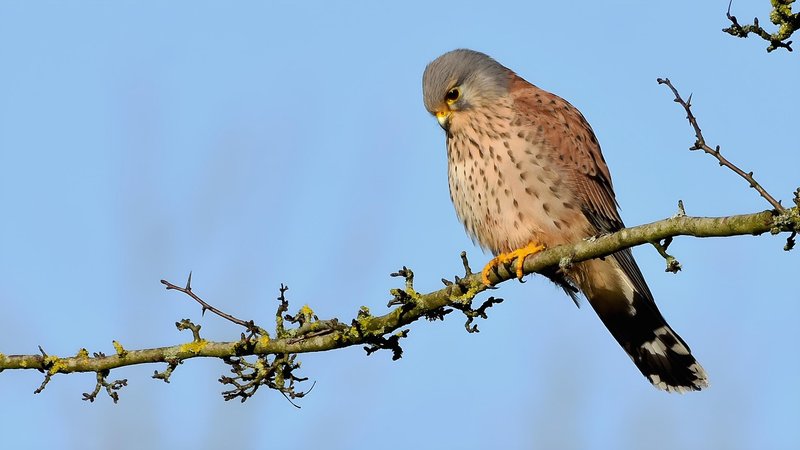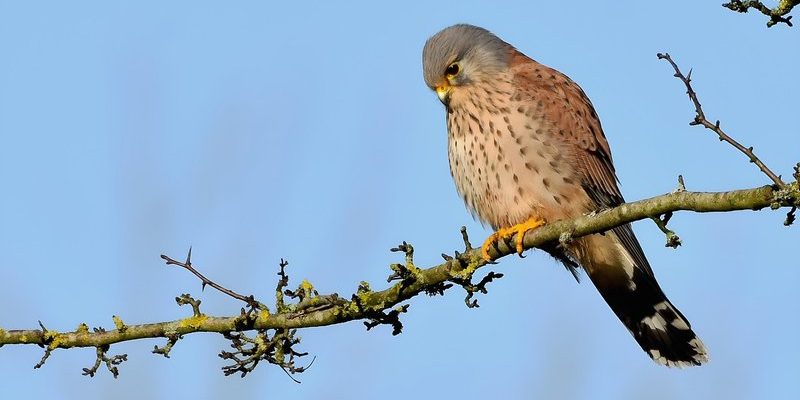
The kestrel is a small bird of prey that has captured the hearts of many wildlife enthusiasts. Often seen hovering in mid-air like a tiny helicopter, this captivating bird belongs to the falcon family, known scientifically as Falco tinnunculus in Europe and Falco sparverius in North America. With its distinct colors and agile hunting style, the kestrel stands out as one of nature’s remarkable aerialists. But what exactly makes this bird so special? Let’s dive deeper into the world of kestrels.
You might be wondering where you can find these birds. Kestrels are quite adaptable, and they thrive in a variety of habitats, including open fields, grasslands, and even urban areas. They are often seen perched on roadside posts or wires, scanning their surroundings for movements. This keen observation is part of their charm and essential for their survival.
Physical Characteristics
Kestrels are easily recognizable due to their striking plumage. Adult males often feature a reddish-brown body with a blue-grey head and wings, while females tend to have a more uniform brown coloration with subtle markings. Both sexes possess a characteristic black “mustache” mark on their faces, lending them a distinct personality. These striking colors not only make them beautiful but also serve a purpose—camouflage during hunting.
These birds are small but mighty, measuring about 9 to 14 inches long, with a wingspan that can reach up to 2 feet. Despite their size, kestrels are incredibly agile flyers, often performing aerial acrobatics that leave observers in awe. Their tail is relatively long and helps with quick turns, allowing them to catch small rodents and insects with precision.
Table of Kestrel Facts:
| Length: | 9 to 14 inches |
| Wingspan: | 20 to 24 inches |
| Weight: | 3.5 to 6.5 ounces |
| Habitat: | Open fields, grasslands, urban areas |
| Diet: | Insects, small mammals, birds |
| Lifespan: | Up to 10 years in the wild |
| Conservation Status: | Least concern |
Feeding Habits
Kestrels are known for their remarkable hunting skills. Their diet mainly consists of small mammals, insects, and occasionally other birds. They often hunt by hovering in the air, using their keen eyesight to spot prey from above. Imagine them as nature’s little drones, flying high and scanning the ground for movement. This technique not only conserves energy but also allows them to assess their surroundings effectively.
Once they spot a meal, kestrels swoop down with impressive speed and precision. Their sharp talons are perfectly designed for grabbing and holding onto slippery prey. They have a unique way of using their beak, which is curved and powerful, to tear into their catch. It’s fascinating to see how each part of their body is designed to complement their lifestyle as hunters.
In urban environments, kestrels often adapt their diet to include more insects, like grasshoppers and crickets. This adaptability is key to their survival, showing just how resourceful these birds can be. Whether you’re observing them in a rural setting or a bustling city, their hunting prowess stands out.
Breeding and Reproduction
The breeding season for kestrels typically starts in spring. They don’t construct nests but rather take advantage of existing structures, such as old buildings, tree hollows, or cliff ledges. This makes them flexible in terms of nesting locations. Females usually lay between 3 to 6 eggs, which they incubate for about a month. This responsibility mostly falls on the females, while males help provide food.
Once the chicks hatch, they rely on their parents for food and protection. Kestrel parents are excellent providers, bringing back a steady supply of fresh prey for their growing young. As the chicks grow, they become increasingly active and curious about their surroundings, often seen peering over the edges of their nest. It’s a heartwarming sight—the parents’ diligent care and the eagerness of the young ones venturing into the world.
Behavior and Social Structure
Kestrels are generally solitary birds, but during the breeding season, you might see them working together with their mates. Their territorial behavior is quite pronounced, especially when it comes to defending their nesting sites. Males are known to engage in dramatic aerial displays to assert their territory, a mix of swooping and diving that is as much about showmanship as it is about warning off competitors.
Even though they are not highly social in the traditional sense, kestrels communicate through a variety of vocalizations. From high-pitched calls that sound like small whistles to sharp screams, their sounds can convey different messages—whether it’s to attract a mate or signal danger. This complex communication adds to the charm of observing them in nature.
Despite their fierce nature as predators, kestrels can be quite vulnerable. They face threats from habitat loss, pesticides, and predation from larger birds. Conservation efforts are in place in many regions to help protect their habitats and populations, ensuring that future generations can enjoy the sight of these remarkable birds.
Interesting Facts About Kestrels
Kestrels are full of surprises! For starters, did you know that they have the ability to see ultraviolet light? This unique trait allows them to spot urine trails left by small mammals—essentially turning their hunting skills up a notch. It’s a fascinating adaptation that gives them an edge in locating prey that would otherwise be hidden.
Another interesting fact is their ability to hover precisely in one spot. They can maintain a stationary position in the air, thanks to their unique wing structure and rapid wingbeats. This hovering allows them to quickly assess the ground below, making sure they don’t miss any potential meals. It’s a sight to behold—your heart can’t help but race when you see one gracefully hovering against a backdrop of blue sky.
Lastly, kestrels are often used as a symbol of freedom and wildlife conservation. Their presence in an ecosystem often indicates a healthy environment, as they thrive in areas where there is biodiversity. By protecting the kestrel, we also contribute to the overall health of the ecosystems they inhabit.
FAQ
What do Kestrels look like?
Kestrels have a distinctive appearance that makes them easily recognizable. Males typically display a mix of reddish-brown and grey plumage, with blue-grey heads. Females, on the other hand, are more uniformly brown but exhibit similar markings. Both genders have a defining black “mustache” mark, adding character to their charming looks.
Are Kestrels good pets?
While kestrels are fascinating birds, they are not suitable as pets. They are wild creatures that require specific environments and diets to thrive. Additionally, in many places, it is illegal to keep birds of prey without special permits. It’s best to admire these birds from a distance in their natural habitats.
How do Kestrels hunt?
Kestrels hunt primarily by hovering in the air above open ground. With their keen eyes, they spot small mammals and insects below. Once they identify their target, they swoop down with incredible speed. This method of hunting is not only effective but also energy-efficient, allowing them to cover large areas in search of food.
Where do Kestrels migrate?
Some populations of kestrels are migratory. For instance, American kestrels may migrate south for the winter, seeking warmer climates where food is more plentiful. Their migration patterns vary by region, with some kestrels traveling thousands of miles to find suitable habitats during colder months.
What is a group of Kestrels called?
A group of kestrels is referred to as a “kettle.” This term is used for several birds of prey that may soar together in thermal currents. While kestrels are generally solitary, they can sometimes be seen in small groups, especially during migration or roosting.
How long do Kestrels live?
In the wild, kestrels typically have a lifespan of about 5 to 10 years, though some can live longer under ideal conditions. Factors such as food availability, predation, and habitat quality all influence their longevity. A healthy kestrel in a good habitat might just surprise you with how long it can thrive.
What threats do Kestrels face?
Kestrels face several threats, primarily due to habitat loss and pesticide use. Changes in agricultural practices can reduce their prey availability, putting pressure on their populations. Additionally, climate change is affecting their habitats, prompting conservation efforts to protect these delightful birds.
How can I help Kestrels?
One of the best ways to help kestrels is to support habitat conservation efforts in your area. You can also create a wildlife-friendly environment by planting native plants that attract insects, or even by putting up birdhouses designed for kestrels. Every little bit helps in preserving the environment where these beautiful birds can thrive.
Are Kestrels dangerous to pets?
Generally, kestrels pose little threat to household pets, especially larger ones like dogs. However, they do hunt small animals, such as rodents and birds. In most cases, they tend to avoid areas with higher human activity, including pets. So, while watching them from a distance, you can feel at ease about your furry friends.
What sounds do Kestrels make?
Kestrels have a variety of vocalizations that include high-pitched whistles and sharp screams. These sounds can convey different messages like warning others about danger or attracting a mate. If you’re lucky enough to hear them, you’ll get a sense of their personality—a mix of playfulness and alertness.
Can Kestrels be trained?
Kestrels are wild birds and not designed for domestication, so they can’t be trained like traditional pets. Falconry enthusiasts may train kestrels for hunting purposes, but this requires specialized training and a strong bond between the bird and falconer. For the average person, it’s best to appreciate their wild nature from afar.

